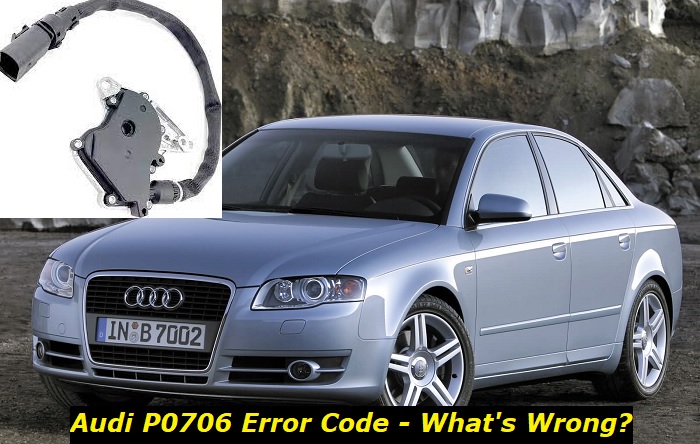The powertrain code P0706 refers to a possible issue with the automatic transmission system of Audi cars. Aside from possible parts damage, the fault is also mostly triggered when the transmission range sensor circuit is not sending accurate data to the engine control unit (ECU).
P0706 code highlights
- Level of urgency:High
- Possible culprits:Transmission range sensor, wiring
- Price for repair:$150 - $500
- If neglected:Limp mode, no shifting
- DIY repairs:Possible but complicated
- Can you drive?Yes, if it drives

Diagnosis and Fixes to the Most Common Causes of the P0706 in Audi
According to mechanics, Audi specialists, and vehicle owners who ran across this problem at some point, the issue usually originates in the following:
1. Dirty Transmission Fluid
The P0706 can be as simple as a dirty or contaminated transmission fluid flowing in your Audi's system. However, the repercussions of this when left unaddressed can be serious and can culminate in damage to your transmission.
When diagnosing a dirty transmission fluid that may be triggering the P0706 fault code in Audi cars, it is important to perform a visual assessment first. The first symptom of a dirty transmission fluid is if its color has changed drastically from the original. The transmission fluid in its pure form should be pink or red in color.
If the fluid appears brown, black, blue-gray, or any other non-clear color, then it is likely an indication that dirt or debris has contaminated the fluid and needs to be replaced. Another sign that suggests dirt in the system is if there are visible particles floating around in the transmission pan when removing it for inspection.
The next step after performing a visual inspection would be to utilize other tools such as a dipstick or a transmission pressure test to assess the condition of the fluid. The transmission dipstick should be pulled and inspected for any level, moisture, and debris content. If there is evidence of excessive dirt or water in the system, then it could be an indication that a flush may be necessary. A transmission pressure test can also provide more information about what kind of contaminants are present in the system.
The last step would be to remove and replace the dirty transmission fluid with fresh new fluid. This is typically done by flushing out all of the old fluid from the system. After removing all of the fluid, refill it with clean oil that meets OEM specifications. It is recommended to use synthetic oil as opposed to conventional oil due to its superior properties in reducing wear and tear on the transmission. Once the fluid has been replaced, reset any fault codes associated with it and test drive the vehicle to ensure its correct operation.
2. Damaged Transmission Valve Body
The transmission valve body is a critical component of the automatic transmission system in Audi vehicles. It is responsible for controlling fluid pressure and flow, which determines the shift points, timing, and gear ratios.
When the valve body is damaged or fails to operate properly, it can interfere with how quickly and smoothly an Audi vehicle shifts gears. As a result, drivers may experience delayed shifting or jerkiness when accelerating or decelerating. Additionally, this issue can also trigger the fault code P0706: "Transmission Range Sensor Circuit High Input" on the vehicle's diagnostic computer.
To diagnose damage to the transmission valve body that may be causing a P0706 fault code, start by performing a manual checkup of the entire transmission system. Check the transmission fluid level, color, and condition. Fluid contamination may be visible in the form of metal shavings or other debris. If necessary, drain and refill the transmission fluid to restore proper lubrication for smoother shifting as discussed in the first item of this list.
If these steps do not resolve the problem, then you should inspect all electrical connections associated with the transmission range sensor. Make sure that they are clean and secure. Be sure to clear any lingering fault codes from your vehicle's diagnostic computer before testing further. These are important processes in isolating the problem to avoid unnecessary repairs from a misdiagnosis.
To test if a damaged valve body is responsible for triggering fault code P0706, use an OBD-II scanner to monitor shifting performance while driving at various speeds. If there is a significant difference between shift points during acceleration or deceleration, then the transmission valve body may be the culprit.
If a damaged transmission valve body is indeed responsible for triggering fault code P0706, then it must be replaced to restore proper shifting performance. Be sure to use only genuine OEM Audi parts when doing this repair. Additionally, you should also flush and refill the transmission fluid to ensure that no debris from damaged parts remains in the system.
3. Faulty Transmission Range Sensor and/or Transmission Position Sensor
The transmission range sensor monitors the transmission speed while the transmission position sensor determines the placement of the transmission shifter. When one or both of these fails, it can activate the P0706 fault code coupled with transmission-related issues.
Diagnosing a faulty transmission range sensor and/or transmission position sensor that may be causing the P0706 fault code typically starts by looking at obvious signs pointing to the problem. If there is visible damage to any of these sensors, such as rust or dirt on them, they should be checked immediately. Other signs of a possible fault are difficulty shifting gears, jerking movements when shifting gears, an illuminated engine light, or general difficulty driving the vehicle.
The next step in diagnosing this problem is recognizing the symptoms associated with it. These can include long shift times between gears, excessive revving when changing from one gear to another, and slow acceleration throughout all of the gears. Additionally, a technician will use a multimeter for further testing by checking for electrical signals that should be present when the engine is running.
The solution for this type of problem most often involves cleaning and/or replacing any faulty transmission range sensor and/or transmission position sensors. It is essential to do this as soon as possible since a malfunctioning sensor can cause further problems with other components in the vehicle if left unchecked.
In some cases, additional repairs may be needed after the new sensors are installed, such as a software update or reprogramming of other components in the vehicle. Once all necessary repair work has been completed, drivers should be able to experience smooth shifting between gears without any difficulty.
Additionally, the P0706 fault code should no longer appear on their dashboard display once these repairs have been made. It will likely take some time for the new sensors to adjust, so it is important to be patient and allow them to do their job properly.
Finally, regular maintenance should be done on the vehicle for these sensors to remain in proper working order over the long term. With proper care, a transmission range sensor and/or transmission position sensor should function correctly in the future.
4. ECU Malfunction
Sometimes, the problem may be as simple as a glitching engine control unit (ECU) that manages the different electrical functions of the vehicle, including the transmission control unit (TCU) responsible for taking care of everything that is transmission-related in Audi cars. If the problem is not gone the next time you restart your vehicle or it tends to appear in its system intermittently, the ECU is likely malfunctioning in some way.
The P0706 fault code may be a result of a software or hardware-related problem with the ECU. To diagnose such an issue, it is best to inspect the wiring that runs from the ECU and TCU as well as any associated sensors. If there are any obvious signs of shorting or damage in the circuitry, sensors, or modules, it is likely that the wires, connectors, sensors, TCU, and/or the ECU itself need to be replaced.
If there are no physical signs of damage in the ECU and its related components, the problem may likely be software-related. In this case, reflashing the ECU usually does the trick, which will recalibrate the settings of your auto's operating system within its manufacturer's recommended settings.
Conclusion
It is important to note that any repairs made in relation to the P0706 fault code in Audi vehicles should only be done by a qualified technician who has experience working with them. They will have access to all of the necessary replacement parts and tools needed in order to get your car running smoothly again.
Furthermore, they can provide advice regarding preventative maintenance measures that you can take to help keep your car in good condition going forward. By following these steps, you should be able to avoid any further issues with the P0706 fault code in your Audi.
About the authors
The CarAraC research team is composed of seasoned auto mechanics and automotive industry professionals, including individuals with advanced degrees and certifications in their field. Our team members boast prestigious credentials, reflecting their extensive knowledge and skills. These qualifications include: IMI: Institute of the Motor Industry, ASE-Certified Master Automobile Technicians; Coventry University, Graduate of MA in Automotive Journalism; Politecnico di Torino, Italy, MS Automotive Engineering; Ss. Cyril and Methodius University in Skopje, Mechanical University in Skopje; TOC Automotive College; DHA Suffa University, Department of Mechanical Engineering






Add comment